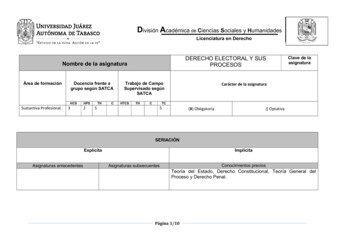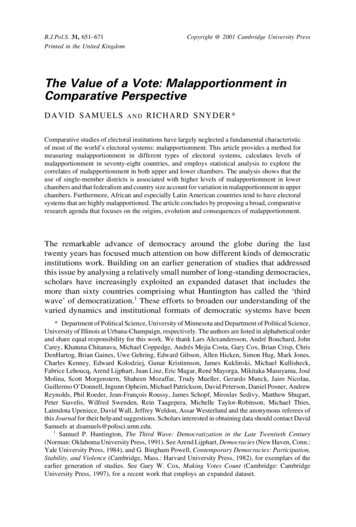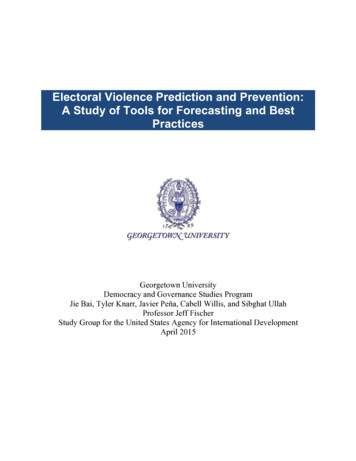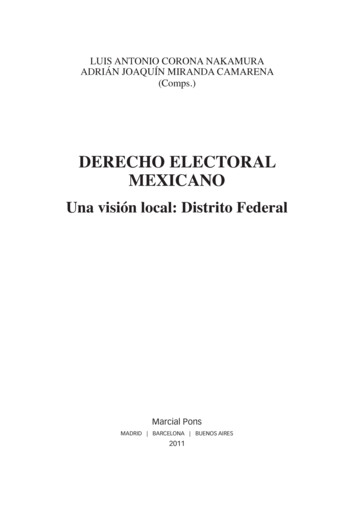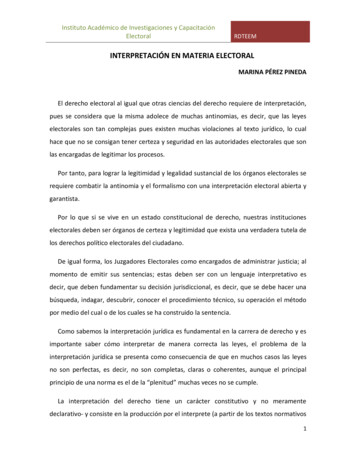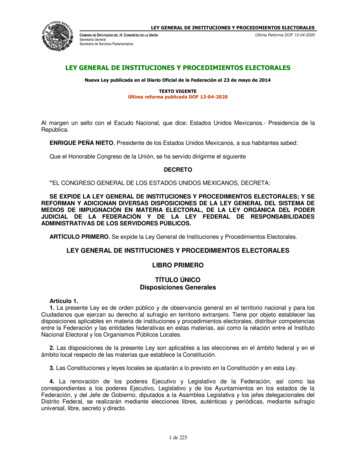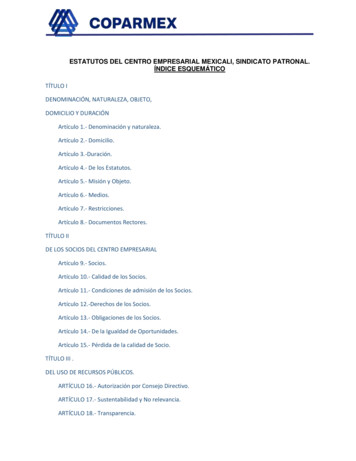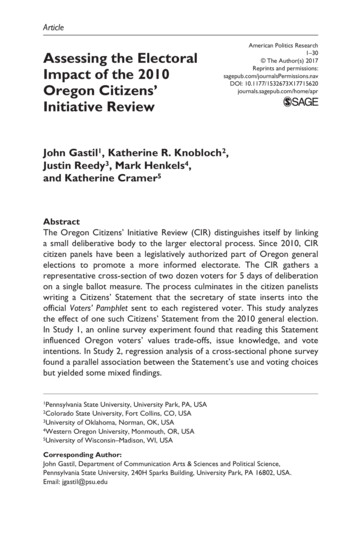
Transcription
715620American Politics ResearchGastil et al.ArticleAssessing the ElectoralImpact of the 2010Oregon Citizens’Initiative ReviewAmerican Politics Research 1 –30 The Author(s) 2017Reprints and ps://doi.org/10.1177/1532673X17715620DOI: aprJohn Gastil1, Katherine R. Knobloch2,Justin Reedy3, Mark Henkels4,and Katherine Cramer5AbstractThe Oregon Citizens’ Initiative Review (CIR) distinguishes itself by linkinga small deliberative body to the larger electoral process. Since 2010, CIRcitizen panels have been a legislatively authorized part of Oregon generalelections to promote a more informed electorate. The CIR gathers arepresentative cross-section of two dozen voters for 5 days of deliberationon a single ballot measure. The process culminates in the citizen panelistswriting a Citizens’ Statement that the secretary of state inserts into theofficial Voters’ Pamphlet sent to each registered voter. This study analyzesthe effect of one such Citizens’ Statement from the 2010 general election.In Study 1, an online survey experiment found that reading this Statementinfluenced Oregon voters’ values trade-offs, issue knowledge, and voteintentions. In Study 2, regression analysis of a cross-sectional phone surveyfound a parallel association between the Statement’s use and voting choicesbut yielded some mixed findings.1PennsylvaniaState University, University Park, PA, USAState University, Fort Collins, CO, USA3University of Oklahoma, Norman, OK, USA4Western Oregon University, Monmouth, OR, USA5University of Wisconsin–Madison, WI, USA2ColoradoCorresponding Author:John Gastil, Department of Communication Arts & Sciences and Political Science,Pennsylvania State University, 240H Sparks Building, University Park, PA 16802, USA.Email: jgastil@psu.edu
2American Politics Research 00(0)Keywordsdeliberation, direct democracy, election reform, initiatives and referenda,political knowledge, public opinionOver the past three decades, the study of deliberative democracy has evolvedfrom a principally theoretical enterprise to an empirical and practical one.Early formulations of deliberation had an abstract quality that contrasted anidealized form of speech against conventional political discourse (Cohen,1989; Habermas, 1989; Mansbridge, 1983). This critique spurred an interestin the actual workings of either proto-deliberative public spaces (Jacobs,Cook, & Delli Carpini, 2009; Mutz, 2006; Neblo, Esterling, Kennedy, Lazer,& Sokhey, 2010) or civic innovations designed to produce high-quality deliberation (Nabatchi, Gastil, Weiksner, & Leighninger, 2012; Ryfe, 2005).Meanwhile, new discussion models, such as Deliberative Polls (Fishkin,2009) and Citizens’ Juries (Crosby, 1995; G. Smith & Wales, 2000), madedeliberative democracy into a practical approach to political reform(Grönlund, Bachtiger, & Setälä, 2014; Leighninger, 2006).Nonetheless, a problem of scale remains for both deliberative theoristsand practitioners (Gastil, 2008; Goodin & Dryzek, 2006; Lukensmeyer,Goldman, & Brigham, 2005). One can hear a reflective and articulate publicvoice through highly structured small-scale deliberation (Fishkin, 2009;Nabatchi et al., 2012), but can such processes effectively influence a widerpublic? Doubts about the potential for forums and discussions to scale uphave helped spur a more systemic approach to deliberation that examineshow macro-level institutions can embody or promote deliberation (Parkinson& Mansbridge, 2012), or tie back to micro-level processes, such as citizenpanels or juries (Gastil, 2000). For example, one approach to bridging thisgap was the British Columbia Citizens’ Assembly, which used a small deliberative body to draft an electoral reform put to a public vote (Warren &Pearse, 2008). Although the Assembly’s recommendation did not meet asupermajority requirement, it did earn 57% support and suggested the potential for making such linkages.A new opportunity to study the connection between micro-level deliberation and macro-level institutions comes from a unique electoral reform in thestate of Oregon. On June 26, 2009, that state’s governor signed House Bill2895, which authorized Citizens’ Initiative Review (CIR) panels for the general election. In the summer of 2010, two stratified random samples of 24Oregon citizens deliberated for 5 days on two separate ballot initiatives(Knobloch, Gastil, Reedy, & Cramer Walsh, 2013). At the end of each week,these CIR panelists produced a written Citizens’ Statement that the secretary
Gastil et al.3of state prominently placed in the Voters’ Pamphlet sent to each registeredvoter. Official state voter guides constitute a popular platform that can potentially sway a large portion of the electorate (Bowler & Donovan, 1998),though they are used more often by more interested and knowledgeable voters (Mummolo & Peterson, 2016). A CIR Statement could have greater influence in Oregon because it is a vote-by-mail state where one’s ballot andpamphlet arrive in sync. Thus, the Oregon CIR presents a critical case inwhich officially sanctioned small-scale deliberation has a mechanism forinfluencing elections.This study examines the sturdiness of the bridge the CIR aims to buildbetween an intensive weeklong deliberation and the less reflective, or moreheuristic (Lupia, 2015; Popkin, 1994), behavior of a large electorate. We useexperimental and cross-sectional surveys to examine associations betweenCIR Statement use and voters’ policy-relevant knowledge, value considerations, and voting choices. To examine these questions, we provide a widertheoretical context for linking micro- and macro-level deliberation in initiative elections. We conclude by reviewing our findings’ implications for deliberative democratic theory, the CIR in particular, and other electoral reformsthat aim to connect deliberative processes at different social scales.Deliberative Designs and Direct DemocracyDeliberation scholarship fits within a broader reformist tradition in democratic theory (Chambers, 2003; Dryzek, 2010). As Robert Dahl (2000) wrotein On Democracy, “One of the imperative needs of democratic countries is toimprove citizens’ capacities to engage intelligently in political life,” and“older institutions will need to be enhanced by new means for civic education, political participation, information, and deliberation” that fit modernsociety (pp. 187-188).This call for new institutions has been answered by ambitious projects,such as the Australian Citizens’ Parliament (Carson, Gastil, Hartz-Karp, &Lubensky, 2013). Relatively few of these efforts, however, have exercisedlegal authority (Barrett, Wyman, & Coelho, 2012), with prominent exceptions being Canadian Citizens’ Assemblies (Warren & Pearse, 2008) andDeliberative Polls in China (He & Warren, 2012; Leib & He, 2006). Onefeature those exceptions have in common is that they focus on a narrow question preset by the same governmental body that authorized the deliberation.This takes agenda-setting power away from the deliberative body, but in thatrespect, it parallels a venerable form of citizen deliberation in which juriesanswer the narrow questions a judge puts before them (Vidmar & Hans,2007).
4American Politics Research 00(0)The Oregon CIR also has a narrow agenda, even if it stands atop a petitionprocess that lets the public put issues on the ballot (Altman, 2010; Bowler &Donovan, 1998). Another essential feature the Oregon CIR shares withCitizens’ Assemblies is cross-level deliberation: What happens on the smallscale is designed to influence the process and outcomes in a large-scale election (Ingham & Levin, 2017; Warren & Gastil, 2015). When looking acrosslevels, the core meaning of deliberation remains the same (i.e., a process oflearning, moral reflection, and considered judgment) even as its behavioralmeaning shifts away from face-to-face discussion at the micro level to impersonal information flows and decisions at the macro level (Gastil, 2008).Initiative elections provide a particularly important context in which tostudy cross-level deliberation. In spite of their broad popularity (Collingwood,2012), initiative elections have received mixed reviews for their fidelity withpublic preferences (Flavin, 2015; Matsusaka, 2008; Nai, 2015) and theirimplications for minorities, in particular (Hajnal, Gerber, & Louch, 2002;Lewis, 2011; Moore & Ravishankar, 2012). There is also reason to be concerned about the quality of information on which voters judge such laws(Broder, 2000; Gastil, Reedy, & Wells, 2007; Milic, 2015; Reedy, Wells, &Gastil, 2014; Saris & Sniderman, 2004). Voters, however, can learn newinformation during elections—information that can influence voting decisions (Lavine, Johnston, & Steenbergen, 2012; Rogers & Middleton, 2014;D. A. Smith & Tolbert, 2004). Moreover, the relative power of motivatedreasoning depends on the political environment. As Leeper and Slothuus(2014) explain, “people adopt different reasoning strategies when motivatedto obtain different end states” (p. 142).Thus, the problem may lie not with initiative elections in general but withthe availability of accessible and trustworthy information for voters(MacKenzie & Warren, 2012; Warren & Gastil, 2015). Even voters withfavorable attitudes toward direct democracy recognize this problem and support reforming the process to reduce the net influence of conventional, andoften misleading, campaign advertising (Baldassare, 2013; Dyck &Baldassare, 2012). The Oregon CIR aims to provide such an intervention,which voters could come to perceive as a neutral and accessible informationsource.A recent set of survey experiments by Boudreau and MacKenzie (2014)suggest the potential efficacy of such an approach. During the 2010 Californiageneral election, these investigators measured baseline attitudes toward aninitiative on the legislature’s budget process, then conducted a 2 2 experiment. A “party cue” treatment then told voters where the Democratic andRepublican parties stood on the issue, whereas a “policy information” treatment provided information about a fiscal hazard in the status quo that the
Gastil et al.5initiative would alleviate. The results showed that “rather than blindly followtheir party, citizens shift their opinions away from their party’s positionswhen policy information provides a compelling reason for doing so”(Boudreau & MacKenzie, 2014, p. 60). A more recent experiment found thata mock minipublic had modest influence on public attitudes toward SocialSecurity (Ingham & Levin, 2017).In theory, therefore, the Oregon CIR could serve as an effective source ofpolicy information, generated by a small deliberative body for the benefit ofa mass public. Although it does not exercise legislative authority, the OregonCIR could have substantial influence on the electorate through the publication of its Citizens’ Statement, which first appeared in the official 2010Oregon Voters’ Pamphlet. The focal question of this study is whether thatmechanism operates as intended by giving voters information and analysisthey put to actual use when deliberating on the corresponding ballotmeasures.Hypothesizing the CIR’s ImpactTo explain the potential impact of the CIR, we begin by describing the process itself in greater detail. After the Oregon legislature established the CIRin 2009, separate citizen panels were assembled for two statewide ballot measures in the 2010 general election. This article focuses on the Citizens’Statement written by the first CIR panel, which studied Measure 73, an initiative that set a 25-year minimum sentence for multiple counts of certain felonysex crimes and toughened the penalties for repeat DUIs (driving under theinfluence). The second panel looked at a measure establishing medical marijuana dispensaries. Both CIR panels constituted stratified samples of 24Oregon voters who had their expenses covered and were compensated at arate equal to the state’s average wage.An intensive field study found that these panels met high standards fordeliberative quality in terms of analytic rigor, democratic discussion, andwell-reasoned decision making (Knobloch et al., 2013). The 2010 CIR panelon mandatory minimum sentencing met for 5 consecutive days, using a process adapted from the Citizens’ Jury model (Crosby, 1995). The citizen panelists received extensive process training, met with advocates and policyexperts, and still had considerable time for facilitated deliberation—both insmaller subgroups and as a full body—before writing their official CIRStatement for the Voters’ Pamphlet. The panelists collectively wrote the KeyFindings section of their Statement, which contained initiative-relevantempirical claims that a supermajority of panelists believed to be factuallyaccurate and important for voters to consider when casting their ballots.
6American Politics Research 00(0)On the final day, panelists divided into pro and con caucuses to write rationales for supporting or opposing the measure, but the full panel reviewedeven these separate sections before settling on the final version. The Statementadditionally included a brief description of the CIR process and showed thenumber of panelists voting for or against the measure. Afterward, the Oregonsecretary of state put the CIR Statement into the Voters’ Pamphlet (see supplementary material). The Statement had a favorable location in the Pamphlet,as it appeared before the paid pro and con arguments submitted by organizations and individuals.Even so, the Oregon CIR would fail to achieve its intended purpose if voters ignored or dismissed entirely the CIR Statement in the Voters’ Pamphlet.Such minimal electoral influence was a distinct possibility. The 2010 initiative campaigns were low-visibility affairs, with limited campaign spendingboth pro and con in a non-Presidential election year.1 In that election, votersalso had no prior frame of reference for the CIR. Voters generally view official guides as useful sources of information for ballot measures (Bowler,2015; Bowler & Donovan, 1998; Canary, 2003), but the same informationseeking voters who use these guides could also prove least likely to be persuaded by the addition of the CIR to their information pool (Mummolo &Peterson, 2016; Valentino, Hutchings, & Williams, 2004).If a CIR Statement does influence voters, it could do so in at least threeways, as summarized in Table 1. First, the recommendation of the majority ofCIR panelists could serve as a powerful heuristic for initiative voting (Lupia,2015), and such cues have been shown to have impacts even on unsophisticated voters (Boudreau, 2009; Goren, 2004). Second, the pro/con sections ofthe Statement could influence readers’ values trade-offs and voting choices(Lau & Redlawsk, 2006). Third, the Key Findings portion of the Statementcould improve the accuracy of voters’ understanding of empirical issues relevant to the initiatives (Estlund, 2009; Luskin, Fishkin, & Jowell, 2002).As to the first of these effects, when the CIR panelists do not split evenly(and they broke 21 to 3 on the sentencing issue studied herein), the balance ofpanel votes could serve as a powerful signal. A substantial majority of votersclaim they need more accurate electoral information (Baldassare, 2013;Canary, 2003), and those lacking both political knowledge and partisan allegiances are particularly rudderless in initiative elections (Gastil, 2000). Inthose cases, endorsement messages can have considerable sway (Bowler &Donovan, 1998; Burnett & Kogan, 2015; Burnett & Parry, 2014; Lupia,2015), so the implicit advice of voters’ peers could persuade those seeking atrustworthy recommendation.Second, when the arguments in the CIR Statements invoke values, theycould shift how voters judge corresponding value trade-offs in the
7Gastil et al.Table 1. Hypothesized Paths of CIR Influence on Initiative Voting Choices.Element of CIRStatementHypothesized effectThe final vote of the CIR Direct voting cuepanelistsValues addressed in thePro/Con sectionsShift in judgmentsabout values tradeoffValues-voting linkagestrengthenedFactual claims validated/ More accuraterejected in Key Findings empirical beliefsand Pro/Con sectionsEmpirical beliefsvoting linkagestrengthenedEmpirical evidence of thisinfluence for CIR Statementreaders versus nonreaders,controlling for other influencesReaders learn how panelistssplit on the measure andbecome more likely to vote inalignment with the majorityReaders change their stances onthe perceived trade-offs amongvalues that influence theirvoting choicesReaders develop values trade-offjudgments more predictive oftheir voting choicesReaders develop more accuratebeliefs on the initiative-relevantempirical claims that influencetheir voting choicesReaders’ final vote preferencesbecome more dependent onthe balance of their relevantempirical beliefsNote. CIR Citizens’ Initiative Review.initiatives (Yankelovich, 1991). Such judgmental shifts could alter thecredence or priority that voters give to opposing values claims. On suchvalues questions, voters’ cultural orientation (Gastil, Braman, Kahan, &Slovic, 2011; Kahan, Braman, Gastil, & Slovic, 2007) and their liberalconservative self-identification (Zaller, 1992) provide strong guidance,but there can be some slippage between voters’ values and their choices(Lau & Redlawsk, 2006). The Statement’s Pro and Con section couldexpose voters to relatively clear and often value-based arguments thatincrease the values–votes correspondence. The CIR Statements are written by lay citizens, whom voters might view as especially credible (Gastil,2000; Leighninger, 2006), and CIR panelists are likely to use languagethat parallels that of the general public, thereby making it easier for readers to synchronize their values with one or the other side of the initiative.In sum, the Statement could shift voters’ value trade-off judgments whilestrengthening the ties between their values and their votes.
8American Politics Research 00(0)Finally, reading the Key Findings and Pro and Con arguments in the CIRStatement could cause voters to consider new information (Cappella, Price,& Nir, 2002). Individuals’ issue-relevant empirical beliefs can become distorted through the lenses of their prior political and cultural commitments(Jerit, Barabas, & Bolsen, 2006; Kahan et al., 2007; Kuklinski, Quirk,Schwieder, & Rich, 1998) and even resist corrective messages (Nyhan &Reifler, 2010). This can occur even in low-information environments, such aswith statewide ballot measures (Reedy et al., 2014; Wells, Reedy, Gastil, &Lee, 2009).To the extent that the neutral portion of the CIR Statement provides empirical content and analysis, it could serve as an information conduit that overrides the more biased claims typical of initiative elections (Boudreau, 2009;Boudreau & MacKenzie, 2014; Broder, 2000; Ellis, 2002) and the ideologicalcues found in ostensibly neutral fact-checking efforts (Garrett, Nisbet, &Lynch, 2013). Knowledge gains of this sort have been observed in previouspublic forums with less intensive deliberative designs (Farrar et al., 2010;Grönlund, Setälä, & Herne, 2010). As with values, the net effect could includenot only more accurate beliefs but also stronger links between empiricalbeliefs and the voting choices they buttress.To test these potential impacts, we present two studies. The first assessescausal influence through an online survey experiment with likely votersexposed to different stimuli. The second uses a cross-sectional phone surveyof Oregonians who had already voted to estimate the independent associationbetween reading the CIR Statement and voters’ attitudes toward the corresponding ballot measure.Study 1An online survey experiment was designed to assess whether the CIRStatement was even capable of changing voters’ preferences, attitudes, andbeliefs. Measure 73 (hereafter called the “sentencing measure”) provided theclearest opportunity for CIR influence. This measure’s ballot title said that it“requires increased minimum sentences for certain repeated sex crimes,incarceration for repeated driving under influence.” This included raising“major felony sex crime” minimums from 70 to 100 months up to 300 monthsand setting a 90-day minimum class C felony sentence for a second offenseof driving under influence of intoxicants (DUII).A September phone survey pegged statewide voter support for the measure at 67% to 73%,2 but the CIR panelists wrote a scathing critique and sidedagainst it 21 to 3. The testimony against the measure carried considerablesway during the CIR’s 5-day deliberations, which revealed potential
Gastil et al.9unintended consequences of the proposed law even its proponents had notconsidered fully (Knobloch et al., 2013).This contrast created the opportunity for the CIR Statement to have animpact when it appeared in the October Voters’ Pamphlet. Support for thesentencing measure dropped in the final days of the election to just 57% ofthe vote, though it is common for initiatives to lose a degree of support as theelection approaches—even without a strong opposition campaign (Bowler &Donovan, 1998). Our survey experiment tested whether the CIR could haveaccounted for some of the measure’s lost support.MethodSurvey sample. We collected a sample of 415 respondents from an online pollconducted by YouGov/Polimetrix from October 22 to November 1, 2010.The target population was registered Oregon voters who said they were likelyto participate in the election, excluding those who had already voted or readthe Voters’ Pamphlet. The RR3 response rate was 41% and approximatedOregon’s party registration and ideological profile. (Statistical power andmissing data imputation are discussed at the end of this section.)Experimental treatment. The experimental manipulation came at the front ofthe survey, immediately following screening questions. Respondents wereassigned at random to one of four groups:1.2.3.4.Those in a control group received no further instruction and proceeded to the survey;Those in a modified control group were shown an innocuous letterfrom the secretary of state introducing the Voters’ Pamphlet;Those in the third group saw the official Summary and FiscalStatement on the sentencing measure—the same content that appearedin the Pamphlet; andThose in the fourth group saw the full CIR Statement on the sentencing measure (see supplementary material).Survey measures. After the experimental treatment, the survey posed the following question:One of the issues in this year’s general election is statewide Initiative Measure73, which would increase mandatory minimum sentences for certain sex crimesand DUI charges. Do you plan to vote yes or no on Measure 73, or have you notdecided yet?
10American Politics Research 00(0)Those who declared themselves undecided were asked the follow-up, “If theelection were being held today and you had to decide, would you probablyvote yes or no on Measure 73?” Those who initially gave an answer of “Yes”or “No” were asked, “Are you fairly certain you will vote [Yes/No] onMeasure 73, or is there a chance you could change your mind?” These questions yielded a dichotomous measure of Sentencing support (yes 1, no 0)and a 7-point Sentencing support certainty scale that ranged from 3 (certainto oppose) to 3 (certain to support).To test whether reading the CIR Statement boosted voters’ confidence intheir decision, a simple yes/no question came next: “Would you say you’vereceived enough information on Measure 73 to make a well-informed vote, ornot?” To probe the CIR’s utility as a voting cue, the survey also asked respondents if they could locate the CIR panelists’ position on the sentencing measureon a 5-point scale from strong support to strong opposition. (The supplementary material provides complete wording for this and other survey items.)Subsequent batteries of randomized items measured values and empiricalbeliefs based on preliminary analysis of the campaign arguments advancedfor and against the sentencing measure. The four values items presented arguments for and against the measure as trade-offs among conflicting goods(e.g., “Even for potentially violent crimes, mandatory minimum sentencing isunjust because it fails to consider individual circumstances”). When not analyzed individually, these items combined into a pro-sentencing values scale(α .71), with a range of 1.5 (strongly disagree) to 1.5 (strongly agree), M 2.84, SD 0.69.The survey also asked respondents if they believed each of six empiricalstatements (e.g., “Mandatory minimum sentencing has already raisedOregon’s incarceration rate well above the national average”). Those whoresponded that they were “not sure” were prompted to state whether theybelieved the statement was “probably true” or “probably false.” This yieldeda 7-point scale from 3 (definitely false) to 3 (definitely true). The supplementary material shows how these six statements related to the content of theCIR Statement, but in each case, one or more Statement sentences could warrant an inference about these statements’ veracity. For later regression analyses, these items were combined into an index that aligned beliefs based onwhether they buttressed or undermined arguments for the sentencing measure. Beliefs that supported the measure were coded as 1, those opposing as 1, and “not sure” as 0. Averaging scores on the items yielded a pro-sentencing empirical beliefs index with M 0.16, SD 0.29.Power and missing data analysis. With a minimum cell size of 96 in the fourexperimental conditions, this study had ample statistical power to detect even
Gastil et al.11small effects (Cohen, 1988). Missing data owing to nonresponse occurred inonly 10 cases (2.4%) for the main dependent variable (attitude toward sentencing measure) and less often for all other measures except the valuestrade-off items, where between 9.6% and 16.1% of respondents declined tostate a position on a given item. For analyses using those items, a linearregression model with five imputations was employed. Results were approximately equivalent to nonimputed analyses, with any changes in statisticalsignificance noted in the text.ResultsOverall impact. Analysis began with a straightforward cross-tabulation of theexperimental treatment by the measure of Sentencing support certainty. Asshown in Table 2, the distribution of responses on the 7-point scale variedsignificantly across the four experimental conditions, χ2(18, N 405) 48.5,p .001.The most striking differences were between the CIR condition and all others. Those reading the CIR statement swung against the measure: 27.8% saidthey would oppose it, and another 20.8% who expressed uncertainty initiallyleaned against it. Across the other three conditions, the comparable figureswere 21.4% initially opposed and only 6.9% leaning against. A corresponding drop in strong support also occurred, with only 9.9% of CIR readers certain in their support, compared with 32.9% of all others.Treating the 7-point Sentencing support certainty metric as a continuousvariable, the CIR Statement condition yielded lower average scores (M 0.41, SD 1.91) than for the control (M 0.65, SD 2.02), secretary ofstate letter (M 0.60, SD 2.19), and summary and fiscal statement conditions (M 0.67, SD 2.37), F(3, 401) 6.19, p .001. Post hoc Tukey’shonestly significant difference (HSD) tests showed significant contrastsbetween each condition and the CIR treatment (max. p .005).Looking just at the binary measure of Sentencing support, a majority ofrespondents were in favor of the measure in the control condition (67.1%), themodified control (65.9%), and the summary and fiscal statement condition(64.4%). In the CIR condition, only 39.5% intended to vote for the measure—a drop of more than 25 percentage points, χ2(3, N 332) 18.2, p .001.Evidence of CIR as voting cue. The net impact of reading the CIR Statementwas substantial, but was it the result of a straightforward voting cue? Thoseexposed to the Statement could read that opposition to the measure was the“POSITION TAKEN BY 21 OF 24 PANELISTS.” When asked if theyrecalled the “position taken by the Citizens’ Initiative Review panelists,”
12American Politics Research 00(0)Table 2. Certainty of Voting Position on Sentencing Initiative by ExperimentalConditions in Study 1.Experimental conditionLevel of sentencing supportcertaintyOppose, certainOppose, could change mindUndecided, probablyopposeUndecided, not leaningUndecided, probably favorFavor, could change mindFavor, certainTotal valid responsesDeclined to d summaryand fiscalstatementRead %1013Note. * The modified control group read an innocuous pdf, which was a letter from thesecretary of state about the administration of the election and the Voters’ Pamphlet.CIR Citizens’ Initiative Review.43.3% recalled correctly that “a large majority OPPOSED the measure,” butalmost as many (40.4%) chose the response option “Not Sure/Don’t Know.”Fourteen respondents (13.5%) thought the panelists ended up, on balance, infavor of the measure. (Seventy-two percent of those in the other three experimental conditions were not even aware of the CIR, and 76.3% of those didnot venture a guess as to how it had voted.)Among those in the CIR condition, recollection of the panelists’ strongopposition proved highly predictive of vote intention. Nearly two thirds(64.4%) of those who correctly recalled the balance of panelists’ votes sidedagainst the measure, whereas those who could not recall the panelists’ voteswere split between opposing (33.3%) and supporting (35.9%) it. (The 14people w
3University of Oklahoma, Norman, OK, USA 4Western Oregon University, Monmouth, OR, USA 5University of Wisconsin-Madison, WI, USA Corresponding Author: John Gastil, Department of Communication Arts & Sciences and Political Science, Pennsylvania State University, 240H Sparks Building, University Park, PA 16802, USA. Email: jgastil@psu.edu 715620



